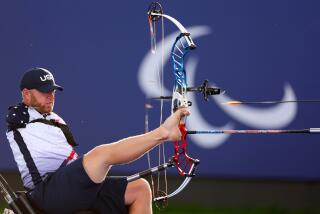Put in Its Place
- Share via
OLYMPIA, Greece — The Olympic Games made a pilgrimage Wednesday to the place where it all began, the sanctuary at Olympia, where a Ukrainian man and a Russian woman conquered heat, dust, wind, nerves and the press of history to win gold in the shotput at the 2004 Games.
Yuriy Bilonog won the men’s event with a throw of 69 feet, 5 1/4 inches on his last throw. Adam Nelson of the United States, winner of the silver medal at the 2000 Sydney Games, won silver again, matching Bilonog’s effort but losing on a tiebreaker. Joachim Olsen of Denmark took third.
Irina Korzhanenko unleashed the longest throw of the year, 69 feet, 1 1/4 inches, to dominate the women’s event, the first competition for women at Olympia. After her final throw, she raised her hands to her face in apparent disbelief, then ran around the field with a blue, red and white Russian flag draped around her shoulders.
The events Wednesday marked an emotional high point of the Games’ return to Greece, connecting today’s spectacle with the traditions that launched the Games in 776 BC.
The contrast could not have been more pronounced.
Here in a remote corner of the Peloponnesian peninsula, the athletes were the focus, perhaps sharing top billing with the stage itself. The crowd for the afternoon finals might have been the largest of any competition so far at the 2004 Games. A precise count was not immediately available, but organizers said they’d printed 15,000 tickets, and a steady stream of fans kept pouring onto the hillsides well after the late-afternoon start of the women’s finals.
“It’s amazing,” U.S. shotputter John Godina said of competing at the place the Games originated. “It’s history. It’s cool.”
“The perfect blend between the modern and the ancient,” teammate Nelson said.
Particularly during the morning preliminaries, when the crowds were smaller, it was as if organizers had taken the charms of a U.S. high school track meet and plunked that sort of scene down amid ancient stones.
There was no hot dog stand. No advertising. Except for a small VIP section, not even any seats. Spectators brought towels and blankets and -- as had the original spectators here thousands of years ago -- sprawled out on the grassy slopes on either side of the field.
On the advice of archeological experts, the throwing field was set up in the middle of the valley. Most big-time meets feature grass infields for the field events. Here, it was hard-packed dirt, and the shot -- the men’s weighs 16 pounds, the women’s 8 pounds 14 3/4 ounces -- landed with an evocative thud, kicking up clouds of dust.
Just over the knoll at the far end of the field, the crumbling remains of buildings that were the glories of the ancients lay baking in the sun, the shadows throwing gray onto the arch through which the competitors entered.
Walking through that arch, the weight of history bore down on the athletes.
“It’s brilliant,” said Australia’s Justin Anlezark, smiling. “They should have given us rocks to throw.”
Said Laura Gerraughty, one of the two members of the U.S. women’s team: “I was pretty well focused on the shoes of the person ahead of me, trying not to throw up. I think I let nerves get the better of me.”
Gerraughty and Kristin Heaston, the other U.S. female competitor, were eliminated in the morning preliminaries.
Korzhanenko got off her winning throw on her third attempt, putting the shot more than four feet farther than Yumileidi Cumba of Cuba, who took silver. Nadine Kleinert of Germany was third.
To hear the shouts of female athletes echoing through the sanctuary at Olympia was to listen in on history. The evidence strongly suggests that the ancient Games were all-male events, the athletes competing in the nude. Everyone -- male and female -- competed Wednesday wearing clothes.
Just after 8:30 a.m., Heaston became the first woman to step onto the field and compete at Olympia.
“An incredible experience,” she said. “I’m sorry I didn’t have a great meet.”
After the men had moved to center stage for their preliminaries, Nelson ripped off the longest throw, 69-5, then retired to catch a sliver of shade by the archway, saying it was “a privilege and an honor to compete here.”
Godina also qualified. But Reese Hoffa didn’t and that quickly, the chances of a 1-2-3 U.S. finish were done.
In the finals, Godina, bronze medalist in 2000 and second-place finisher in 1996, fouled on his first two throws. On his third, he threw 66-3, good enough only for ninth.
On his first throw in the finals, Nelson rocked into the lead, with a throw of 69-5 1/4 . He then had four consecutive fouls.
Because he held the lead after three throws, Nelson threw last during the final three -- meaning he knew what he’d have to beat.
Through five rounds, Bilonog had remained one centimeter, about four-tenths of an inch, behind. On his sixth and final throw, Bilonog matched Nelson’s 69-5 1/4 .
Nelson tore off his outer shirt, cupped the shot to his neck, swirled, twirled, let the ball go -- and fouled again.
Both men ended up with throws of 69-5 1/4 , but because Bilonog had a better backup mark, he was the winner.
“I really thought this would be my day, my year,” Nelson said. “The only person I have to blame is myself.”
He added, in the kind of remark they probably said here once a long time ago about the unscripted drama that sport can provide, “That’s how it goes.”
More to Read
Go beyond the scoreboard
Get the latest on L.A.'s teams in the daily Sports Report newsletter.
You may occasionally receive promotional content from the Los Angeles Times.






